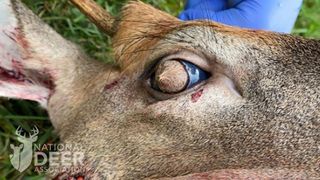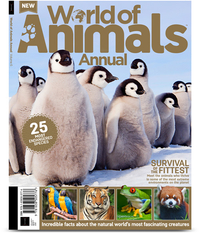Why a dazed deer in Tennessee had hair growing from its eyeballs

A whitetail deer was found stumbling through the streets of Farragut, Tennessee, with thick hair growing out of both of its eyeballs.
The hair protruded from discs of flesh covering both the buck's cornea — the transparent part of the eye that covers the iris and pupil. The bizarre condition, called corneal dermoids, has been documented in just one other whitetail in the state of Tennessee, according to Quality Whitetails magazine, the journal of the National Deer Association.
A dermoid, by definition, is a type of benign tumor made of tissues that usually appear in other parts of the body; in this case, skin tissue complete with hair follicles cropped up in the deer's cornea.
The hairy-eyed deer "maybe could tell day from dark, but I wouldn’t think it would be able to see where it was going," Sterling Daniels, a wildlife biologist at the Tennessee Wildlife Resources Agency (TWRA), told Quality Whitetails. "I’d compare it to covering your eyes with a washcloth. You could tell day from night, but that’s about it."
The same deer tested positive for epizootic hemorrhagic disease (EHD), which can cause fever, severe tissue swelling and loss of fear of humans, according to the Cornell Wildlife Health Lab. This may explain why the disoriented animal wandered into a suburban street in late August 2020 and seemed unaware of the people nearby, Quality Whitetails reported.
However, the illness does not explain why the deer's eyes sprouted tufts of hair.
Related: Survival of the grossest: 8 disgusting animal behaviors
Sign up for the Live Science daily newsletter now
Get the world’s most fascinating discoveries delivered straight to your inbox.
World of Animals Annual: $22.99 at Magazines Direct
The animal kingdom is a fascinating, beautiful and complex world, but it faces an uncertain future. In the past few years, we’ve seen Japan resume whaling and scientists warn that the next decade could prove pivotal for the Earth’s environment and its inhabitants. This annual explores some of the threats faced by 25 of the world’s most endangered creatures and meets the animals that owe their continued existence to the vital Endangered Species Act of 1973.
The hairy skin patches likely formed early in the animal's development, while it was still in the womb, Dr. Nicole Nemeth, an associate professor in the Department of Pathology at the Southeastern Cooperative Wildlife Disease Study unit (SCWDS) of the University of Georgia vet school, told Quality Whitetails. Rather than successfully developing into a clear cornea, the tissue instead formed skin and hair follicles, obscuring the growing deer's eyes.
Beneath the thick hair, the deer's eyes contained all the expected anatomy.
Despite being born with corneal dermoids, the buck had lived to be more than a year old and even grew its first set of antlers before catching EHD, which has no treatment, Quality Whitetails reported. Since the deer survived so long, Nemeth said that the dermoids probably "developed gradually," allowing the animal to adapt to its decreasing field of vision over time.
"How fast [dermoids] develop over time probably isn’t well known and may vary case to case," Nemeth told Quality Whitetails.
Humans can develop dermoids in their eyes, too, causing hair to grow on their eyeballs, Live Science previously reported. The condition is rare, so an eye doctor may only see one or two cases in their entire career. Not all these dermoids cover the center of the cornea, as in the deer's case; some dermoids form at the intersection of the cornea and the white part of the eye, called the sclera.
In this case, the condition can cause blurred vision but doesn't usually cause extreme sight problems, Live Science reported. The dermoids may be removed for cosmetic reasons, but their removal typically doesn’t improve patients' eyesight.
(You can read more about the case of the hairy-eyed deer at Quality Whitetails magazine.)
Originally published on Live Science.

Nicoletta Lanese is the health channel editor at Live Science and was previously a news editor and staff writer at the site. She holds a graduate certificate in science communication from UC Santa Cruz and degrees in neuroscience and dance from the University of Florida. Her work has appeared in The Scientist, Science News, the Mercury News, Mongabay and Stanford Medicine Magazine, among other outlets. Based in NYC, she also remains heavily involved in dance and performs in local choreographers' work.
Most Popular



